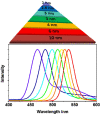Biomedical Applications of Quantum Dots: Overview, Challenges, and Clinical Potential
- PMID: 35530976
- PMCID: PMC9076002
- DOI: 10.2147/IJN.S357980
Biomedical Applications of Quantum Dots: Overview, Challenges, and Clinical Potential
Abstract
Despite the massive advancements in the nanomedicines and their associated research, their translation into clinically-applicable products is still below promises. The latter fact necessitates an in-depth evaluation of the current nanomedicines from a clinical perspective to cope with the challenges hampering their clinical potential. Quantum dots (QDs) are semiconductors-based nanomaterials with numerous biomedical applications such as drug delivery, live imaging, and medical diagnosis, in addition to other applications beyond medicine such as in solar cells. Nevertheless, the power of QDs is still underestimated in clinics. In the current article, we review the status of QDs in literature, their preparation, characterization, and biomedical applications. In addition, the market status and the ongoing clinical trials recruiting QDs are highlighted, with a special focus on the challenges limiting the clinical translation of QDs. Moreover, QDs are technically compared to other commercially-available substitutes. Eventually, we inspire the technical aspects that should be considered to improve the clinical fate of QDs.
Keywords: biosensors; clinical translation; clinical trials; in vivo imaging; photodynamic therapy; quantum dots.
© 2022 Abdellatif et al.
Conflict of interest statement
The authors report no conflict of interests associated with this work.
Figures







Similar articles
-
Exploring the multifunctional roles of quantum dots for unlocking the future of biology and medicine.Environ Res. 2023 Sep 1;232:116290. doi: 10.1016/j.envres.2023.116290. Epub 2023 Jun 7. Environ Res. 2023. PMID: 37295589 Review.
-
Quantum dots, lighting up the research and development of nanomedicine.Nanomedicine. 2011 Aug;7(4):385-402. doi: 10.1016/j.nano.2010.12.006. Epub 2011 Jan 5. Nanomedicine. 2011. PMID: 21215327 Review.
-
Recent developments in carbon dots: a biomedical application perspective.J Mater Chem B. 2023 Apr 5;11(14):3038-3053. doi: 10.1039/d2tb02794a. J Mater Chem B. 2023. PMID: 36919487 Review.
-
Cadmium-containing quantum dots: properties, applications, and toxicity.Appl Microbiol Biotechnol. 2017 Apr;101(7):2713-2733. doi: 10.1007/s00253-017-8140-9. Epub 2017 Mar 1. Appl Microbiol Biotechnol. 2017. PMID: 28251268 Review.
-
Biomedical and biological applications of quantum dots.Artif Cells Nanomed Biotechnol. 2016 May;44(3):885-91. doi: 10.3109/21691401.2014.998826. Epub 2015 Jan 23. Artif Cells Nanomed Biotechnol. 2016. PMID: 25615877 Review.
Cited by
-
Nanotechnology in the Diagnosis and Treatment of Antibiotic-Resistant Infections.Antibiotics (Basel). 2024 Jan 25;13(2):121. doi: 10.3390/antibiotics13020121. Antibiotics (Basel). 2024. PMID: 38391507 Free PMC article. Review.
-
Quantum food and nutrition: Subatomic approaches to nourishment for health and well-being.Asia Pac J Clin Nutr. 2025 Feb;34(1):1-9. doi: 10.6133/apjcn.202502_34(1).0001. Asia Pac J Clin Nutr. 2025. PMID: 39828254 Free PMC article.
-
Arthritic Microenvironment-Dictated Fate Decisions for Stem Cells in Cartilage Repair.Adv Sci (Weinh). 2023 Sep;10(27):e2207715. doi: 10.1002/advs.202207715. Epub 2023 Jul 30. Adv Sci (Weinh). 2023. PMID: 37518822 Free PMC article. Review.
-
Nanotechnology in oncology: advances in biosynthesis, drug delivery, and theranostics.Discov Oncol. 2025 Jun 21;16(1):1172. doi: 10.1007/s12672-025-02664-3. Discov Oncol. 2025. PMID: 40542991 Free PMC article. Review.
-
Visualizing Research Trends in Quantum Dots for Health: A Bibliometric Exploration.Cureus. 2024 Sep 24;16(9):e70132. doi: 10.7759/cureus.70132. eCollection 2024 Sep. Cureus. 2024. PMID: 39463601 Free PMC article. Review.
References
Publication types
MeSH terms
LinkOut - more resources
Full Text Sources
Other Literature Sources

